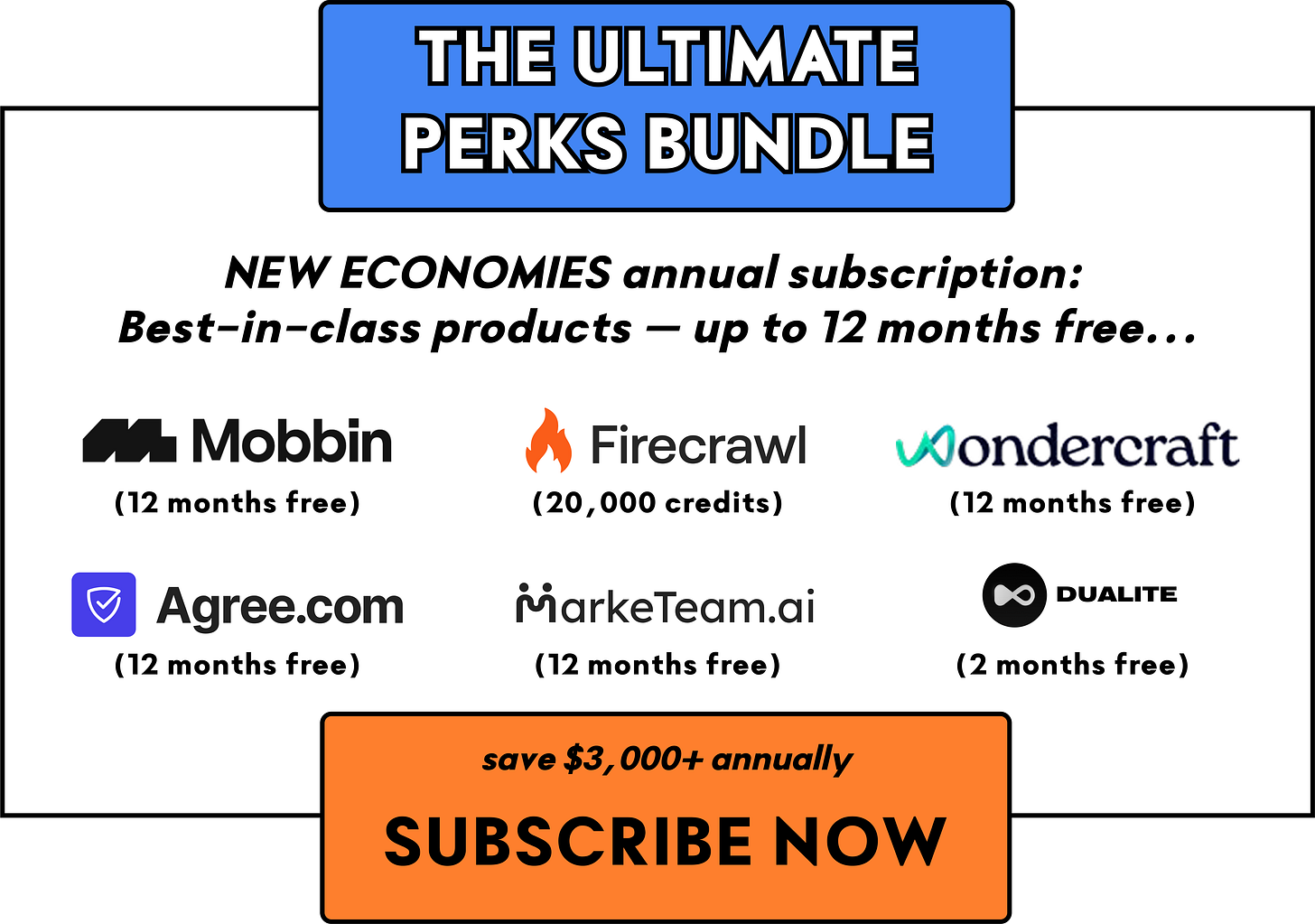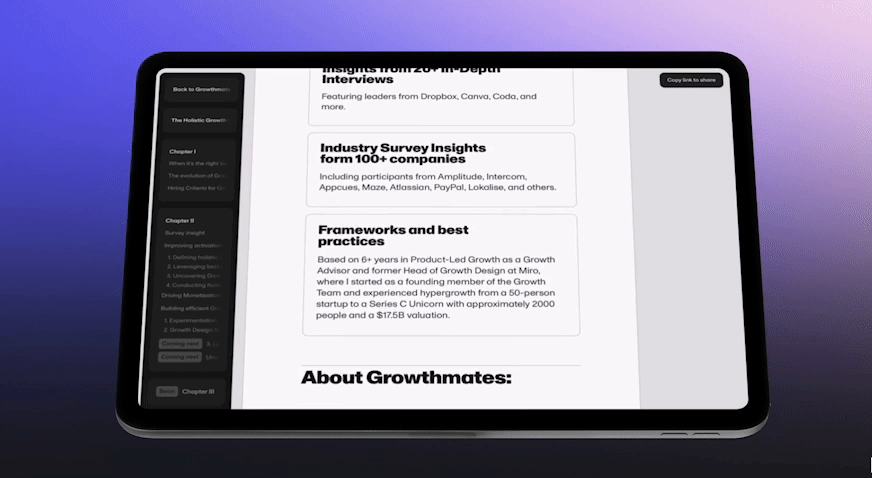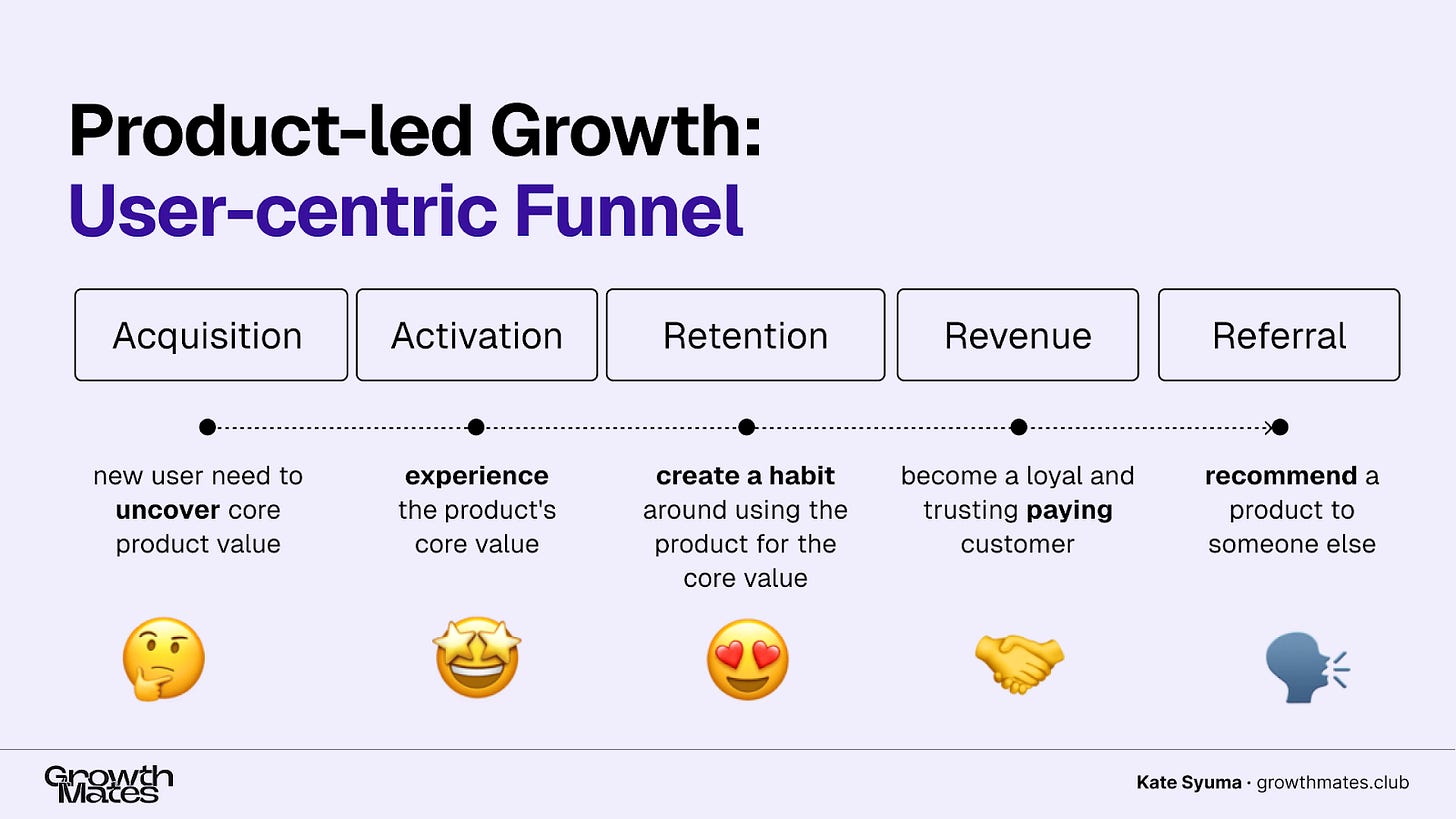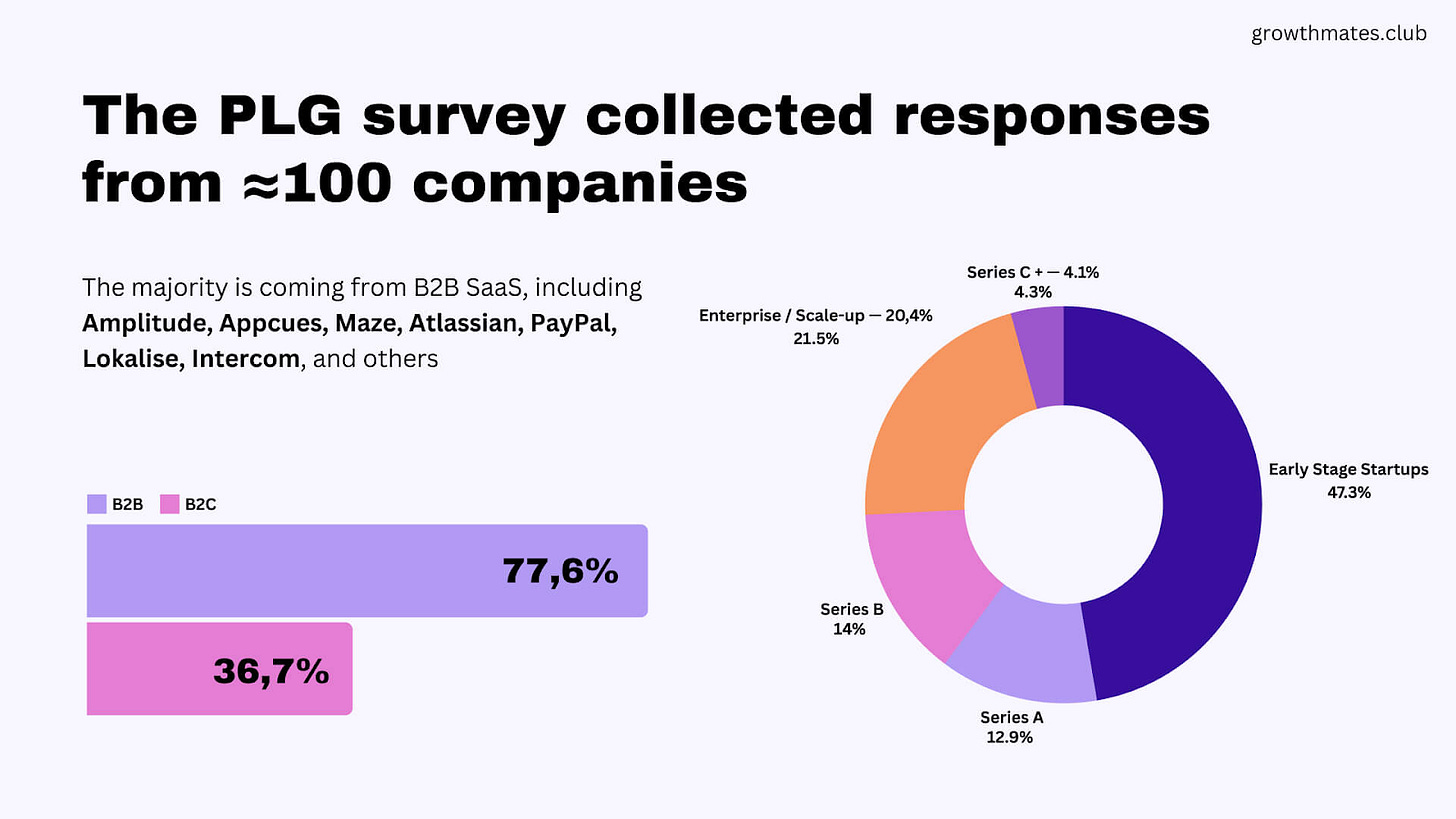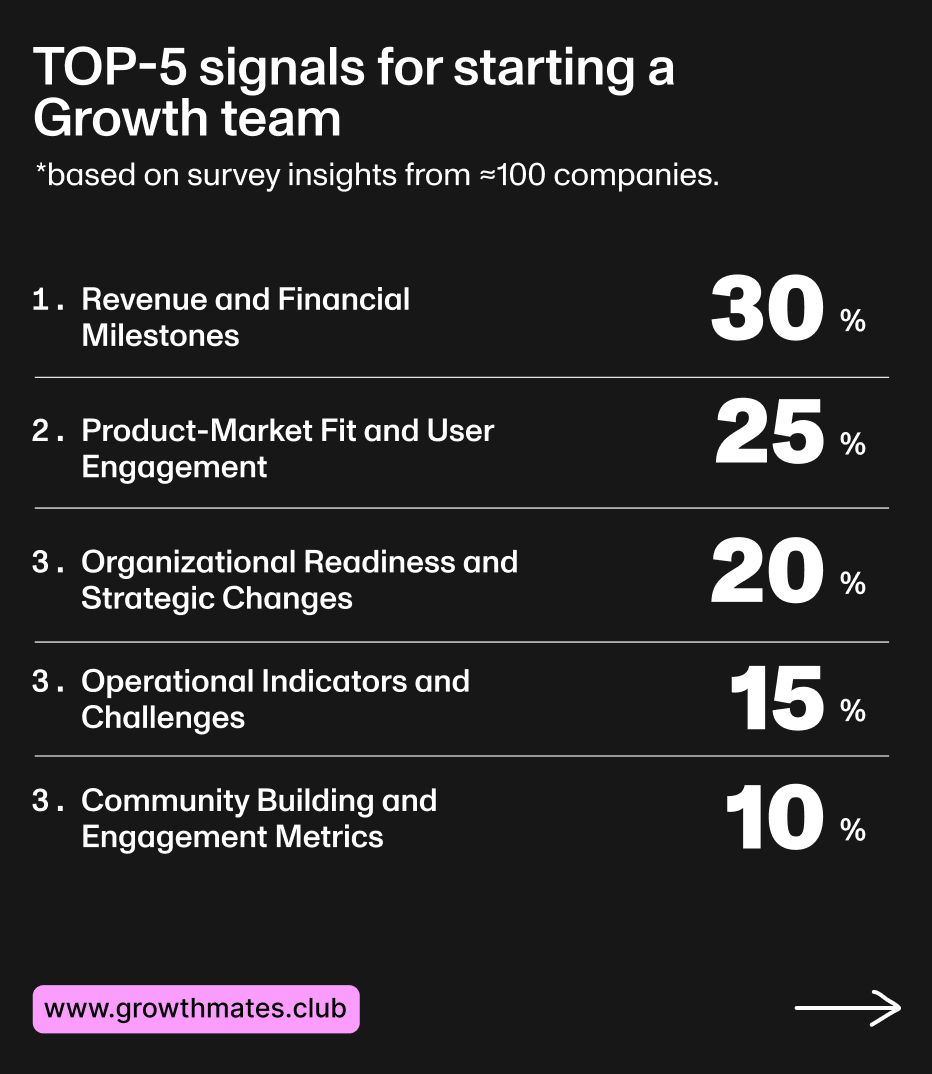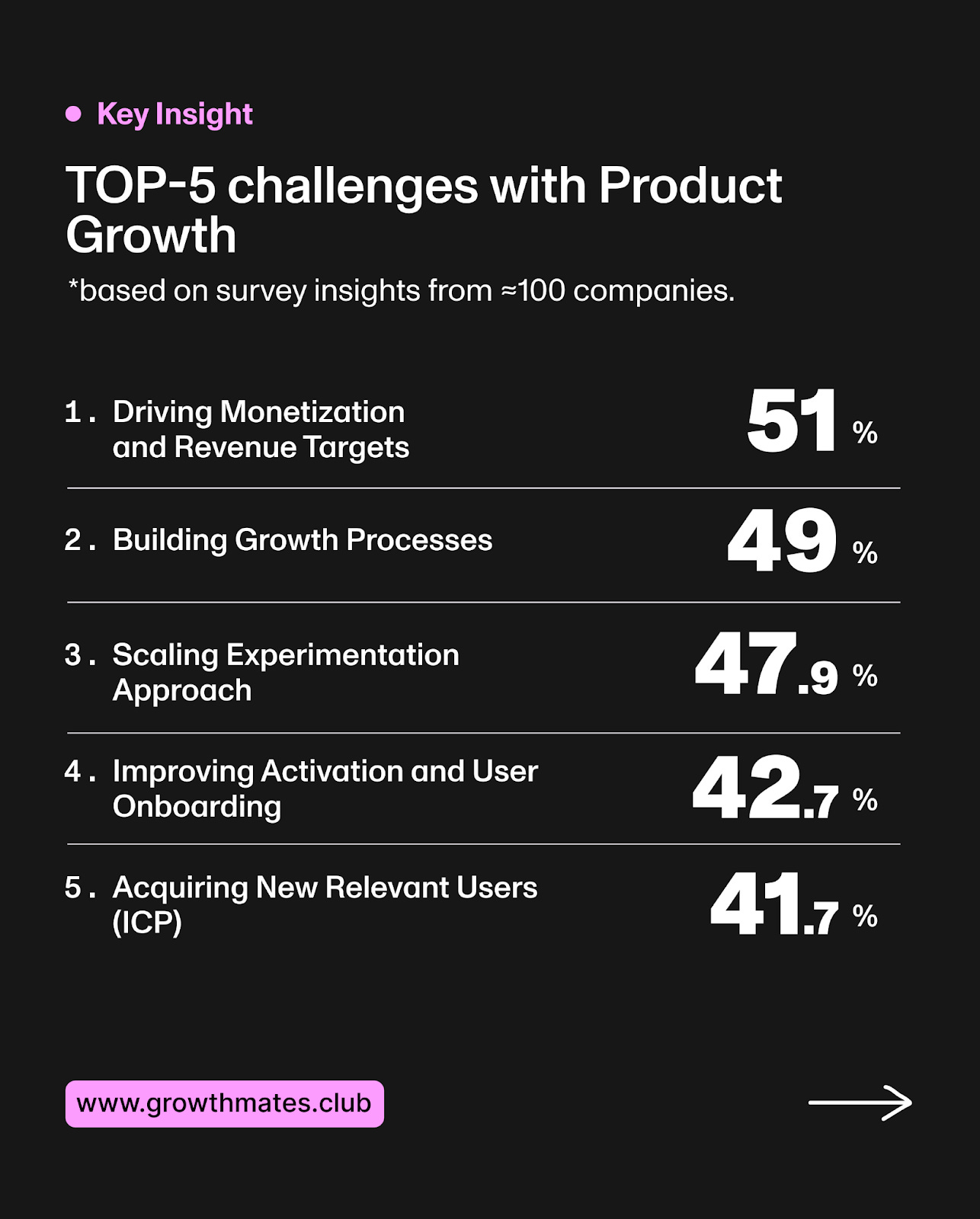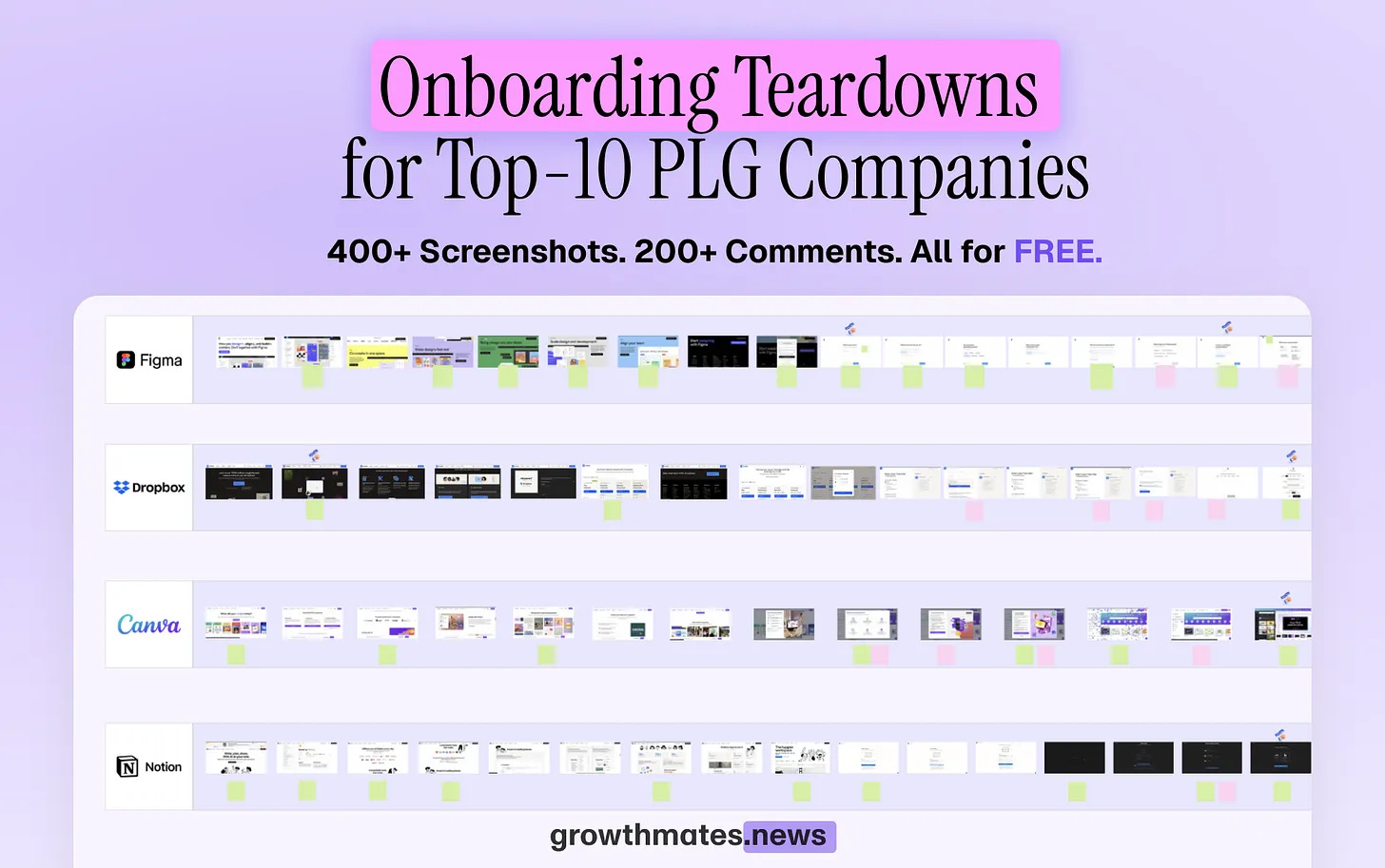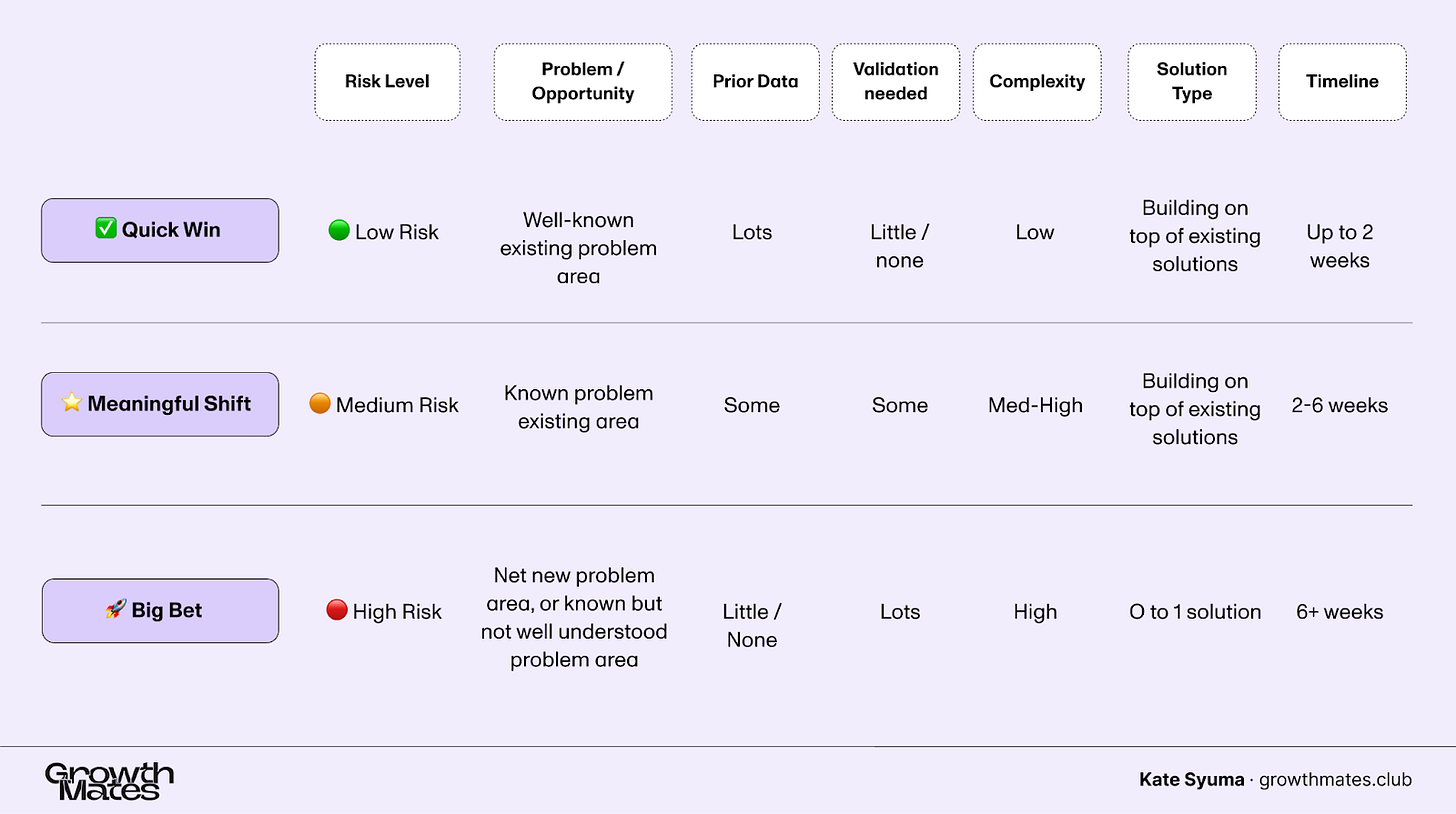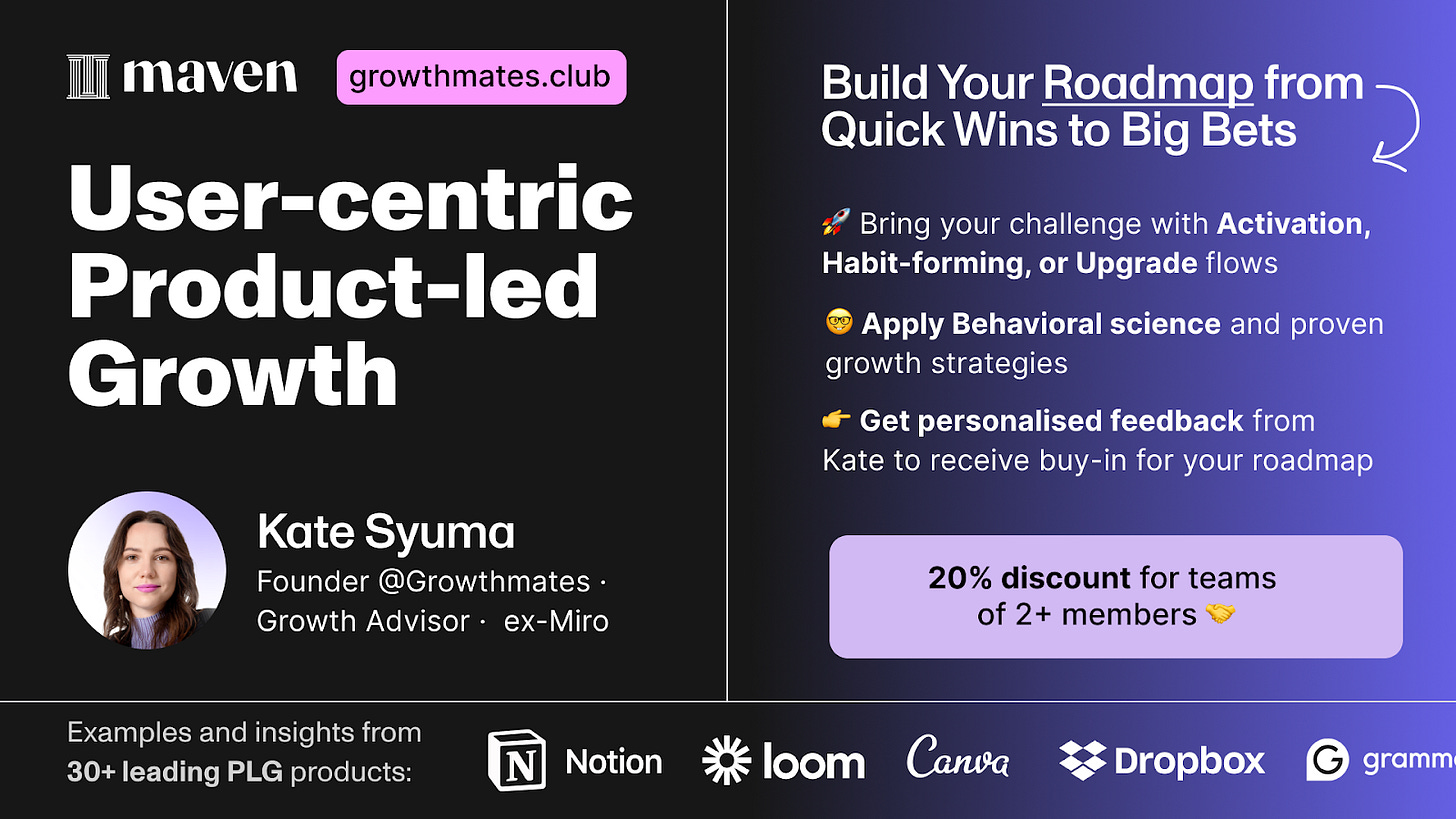The Ultimate PLG Playbook for Early-stage Startups
The Ultimate Perks Bundle. Save Hundreds Of Hours. Discover The Latest Guide - The PLG Playbook for Early-stage Startups
Welcome to NEW ECONOMIES, where we decode the technology trends reshaping industries and creating new markets. Whether you're a founder building the future, an operator scaling innovation, or an investor spotting opportunities, we deliver the insights that matter before they become obvious. Subscribe to stay ahead of what's next alongside 75,000 others.
The Ultimate Perks Bundle
We’ve just launched the ultimate perks bundle — giving you free access to best-in-class tools with your annual NEW ECONOMIES subscription. And we’re just getting started: expect even more, even better discounts over time. What’s included so far?
Mobbin - Discover real-world design inspiration. (12 months for free).
Firecrawl - Turn websites into LLM-ready data. (20,000 free credits).
Wondercraft - Create video and audio content through natural conversation. (12 months for free).
Agree.com - An all-in-one agreements platform with better e-signature, smarter invoicing, and faster payment processing. (12 months for free).
MarkeTeam Unleash the full potential of your marketing team by using AI Agents. (12 months for free).
Dualite - Your full stack AI builder. (2 months for free).
The perks are only available for annual paid subscribers. If you haven’t yet subscribed, most companies allow you to expense this. Access all subscriber benefits by subscribing now.
Hey everyone 👋
This week’s guest contributor is Kate Syuma, founder at Growthmates who was formerly Head of Growth Design at Miro where she led the team for six years.
In 2023, Kate founded Growthmates with the mission to share knowledge that helps others build meaningful products that truly delight users. Over the years, she has collaborated with 15+ B2B and B2C brands — including Grammarly and ManyChat — and created educational content in partnership with Amplitude, Framer, Appcues, UserPilot, and more. Beyond advising startups, Kate has spent her career collecting best practices from industry experts and developing unique frameworks, which she will be sharing in this edition.
The Ultimate PLG Playbook for Early-stage Startups
As the world of startups changes every day, so does how products are built and designed. That’s why, we are publishing The Ultimate PLG Playbook for Early-stage Startups — for you to walk away with tactical takeaways on how you can build and design world-class products that your customers love.
Throughout this guide, we cover the following:
Chapters:
Chapter 1: Getting Started with Product-led Growth
What does “Product-led Growth” truly mean?
The signals to start a Growth team
Who to hire as the First Growth Leader
Chapter 2: Top Growth Challenges and Why Activation is #1 Priority
The Emerging Growth challenges
Activation & User Onboarding: Why it’s your #1 priority
Best practices: Onboarding tear-downs from world-class PLG SaaS companies
Chapter 3: Organizing your Growth roadmap
The importance of a diverse portfolio for a growth roadmap
3 types of initiatives: Quick Wins, Meaningful Shifts, Big Bets
Let’s dive in 🚀
Chapter 1: Getting Started with Product-led Growth
I come from a UX background, and it deeply affects how I think about developing a product. Before I started specializing in Growth, I designed user flows for the entire product, validated them with customers, saw how they struggled and tried to make experiences as intuitive as possible for them.
The lesson that I learned: User Experience is the foundation of your product. There’s no Product-led Growth without it.
If you’re building an AI product, it becomes even more crucial to keep the user in mind, as we can forget about their native experience, being blown away by constant automations we’re running.
“What is good for USER is good for BUSINESS” — this became my professional motto.
Simply, if the product itself is NOT providing an intuitive user experience — it’s NOT self-servable. If the product is not self-servable, it can’t successfully apply the Product-led Growth approach.
What does “Product-led Growth” truly mean?
The term “PLG” or “Product-led-growth” starts with the word “Product”, meaning the product itself and its quality create a necessary foundation for Acquisition, Activation, Monetization, and other growth levers.
Product-Led Growth is the strategy that is driving the distribution of the core product value within the product ecosystem and through external channels to attract, activate, engage, and convert users to paid customers with minimal human interaction. Throughout this journey, users adopt the core value of the product, build habits, and ultimately become loyal and trusting paying customers.
I love looking at “Product-led Growth” from the user-centric standpoint. Imagine it like a holistic path:
→ New user uncovers core product value
→ Experience the product's core value
→ Create a habit around using the product for the core value
→ Becomes a loyal and trusting paying customer
→ Recommend a product to someone else
This is when working on Product-led Growth, we need to treat that as a holistic system — thinking of FLOWS, not isolated features. But the next important question — where to start from if you’re still in your early stages?
The signals to start a Growth team
In my study for the Holistic Growth Playbook, I surveyed 100+ companies from different stages and sizes to have a comprehensive picture and insights that fit various segments.
When it comes to signals: It’s not about headcount — it’s about readiness. You might be ready when you’ve found early product-market fit, your self-serve funnel is showing signs of life (like repeated activation or organic loops), or you’ve identified a core metric that directly links to revenue.
At ManyChat, the team defined an Activation metric tied to NRR before investing in Growth. One of my favorite experts Elena Verna often notes that your Growth team should exist to scale already working systems — not to “find” PMF or build the product from scratch. If you’re still validating your value prop, you likely need more product iteration — not a Growth team yet.
Here are some signals that I collected from 100+ respondents:
PLG isn’t just a strategy — it’s a mindset. If your goal is to build a system that can grow without constant human involvement, that thinking needs to start from day one. Invest early in the foundations: a clear core value, a self-serve experience, and a product architecture that can scale. Without those, no growth tactic will be truly sustainable.
Who to hire as the First Growth Leader
When hiring your first Growth leader, think of them as a "Growth Team of One" — someone who can operate independently across the full funnel and move from insight to execution without heavy support. Based on patterns from 100+ companies, here’s what to look for:
– Strong product intuition to identify and prioritize high-leverage opportunities
– Analytical mindset to make data-informed decisions and run experiments end-to-end
– Attention to high-quality and design skills to shape and test user flows without relying on full design support
– User-centricity and research skills to deeply analyze users, using cognitive psychology to inform solutions.
– Bias for action — someone who’s scrappy, curious, and comfortable testing before scaling
Before launching a formal Growth team, consider starting with a virtual setup — a temporary cross-functional team made up of your existing PM, Designer, and Engineers. This team can begin testing growth hypotheses around Activation and Monetization using your current resources. If the approach proves effective, it can evolve into a dedicated Growth function, or you can bring in an external expert to support and accelerate the process. I regularly help teams set up this model — feel free to DM me on LinkedIn if you’d like to chat.
In the full version of Holistic Growth Playbook, I also prepared an interview guide with some questions that can inspire your hiring process, and examples of Growth Team structures from Amplitude, ManyChat, and more — you can get it here.
Chapter 2: TOP Growth Challenges and Why Activation is #1 Priority
The Emerging Growth challenges
As more companies adopt Product-Led Growth, the challenges have shifted. The old tactics aren’t enough — the bar for user experience is higher, markets are saturated, and users expect instant value, especially with the emerging perception that AI can make everything look like magic.
In our research, the top challenges were clear: monetization, experimentation, and process scaling. But one stood out across every stage — Activation.
Why? Because without it, nothing else moves. Users who don’t experience the product’s core value early on won’t retain, engage, or convert — no matter how good your acquisition or pricing is.
As one founder put it:
“You can’t optimize revenue if users never hit the ‘aha’ moment.”
Let’s explore why Activation is the most leveraged place to invest — and how top teams are redefining it.
Activation & User Onboarding: Why it’s your #1 priority
Activation is where growth either begins — or quietly dies. It’s not a single event, but a journey: from the moment a user searches for a solution, to when they build a habit around your product. Across 80+ onboarding flows we reviewed, one truth kept showing up: most users drop off before they ever reach core value (=getting to the Activation stage).
Activated users aren’t just more engaged — they’re significantly more valuable. Data shows that activated users have 2x higher long-term retention and are 70–80% more likely to convert to paid. That’s why Activation isn’t just a UX challenge — it’s a growth multiplier. The earlier users experience core value, the stronger their path to habit, retention, and monetization.
User Onboarding ≠ First session. This is a holistic user journey that starts when a potential user started looking for a solution to solve their problem. It ends when the user built a habit around solving the problem with your product.
In my newsletter 6 steps of Holistic User Onboarding, I dive deeper into that framework and best practices from Coda, Rows, Dropbox, Loom, and more.
And here, I want to share one more special resource that can help you uncover blind spots and improvements in your onboarding experience.
Best practices: Onboarding teardowns from world-class PLG companies
After years of running onboarding experiments at Miro and advising top SaaS teams, I pulled together everything I’ve learned into one resource: 10 Onboarding Teardowns from top PLG products — now public for the first time.
I broke down what’s working (and what’s not) across Notion, Linear, Figma, Canva, Intercom, Loom, and more. Inside, you’ll find 400+ screenshots, 200+ expert notes, and 5 activation patterns that kept showing up again and again. It’s designed to help you spot what’s missing, simplify your flows, and unlock faster time-to-value. Now, you can get this board here →
Chapter 3: Organizing your Growth roadmap
Why have a Diverse Portfolio as an Early-stage team?
When you’re an early-stage team, it's tempting to chase the biggest growth lever or the most exciting bet. But the smartest teams start with something else: balance. You need a roadmap that includes foundational work, quick wins, and longer-term bets — all working together.
A great example comes from Loom. When I asked their leader on Growthmates podcast, they shared that in the early days, their Growth team focused on fast, lightweight experiments — small changes that delivered measurable impact. These quick wins created early momentum, bought trust across the org, and gave the team space to explore deeper improvements later, like rethinking the onboarding flow and revamping their core recorder.
Foundations always come first. Without clarity on your Activation metric, clear onboarding, or a working self-serve funnel, big bets won’t land. A diverse portfolio isn’t just about spreading risk — it’s about sequencing growth work so every step compounds. So let’s explore how to categorize your roadmap across Quick Wins, Meaningful Shifts, and Big Bets — and how to know where to start.
3 types of initiatives: Quick Wins, Meaningful Shifts, Big Bets
To build a roadmap that actually moves the needle, it helps to organize your initiatives into three categories: Quick Wins, Meaningful Shifts, and Big Bets. Quick Wins help you build trust fast and prove early traction. Meaningful Shifts improve core flows and unlock growth levers. Big Bets are bold, strategic experiments that take more time but can transform the trajectory of your product. The key is knowing when to invest in each — and how to stack them for compounding impact.
I break down this system in detail inside my course, User-Centric Product-Led Growth, where we go deep into how to prioritize, experiment, and align teams around high-quality growth work. If you’d like to join, the next cohort is now open and kicks off in October. In past cohorts, we had peers from companies like Miro, Dropbox, Loom, Grammarly, Revolut, LinkedIn, and more. You’ll be in good company — and in the right room to level up.
Summary: Getting started
Product-led Growth begins with a strong, intuitive user experience. Early activation and onboarding are the biggest growth multipliers, so prioritize delivering core value quickly. Balance your roadmap with quick wins, meaningful shifts, and bold bets to compound impact as you scale.
Now is the time to build!
Connect with Kate Syuma
Want to go deeper or collaborate? Here’s where you can find me:
🔗 Growthmates.club — Explore ways to work together, whether you're looking for a dedicated PLG Advisor or want to run an Onboarding & Activation Sprint to get my fresh perspective, uncover new growth opportunities, and holistic product improvements.
📰 Growthmates Newsletter — Weekly insights, teardown boards, and product wisdom I collect from leaders at companies like Canva, Dropbox, Notion, and more.
🎓 User-Centric Product-Led Growth Course — the next cohort starts on 27th October, and it’s all about building onboarding, activation, and upgrade flows that put the user at the centre — and turn them into paying, loyal customers. Past 60+ students from Dropbox, Atlassian, GitHub, Loom, and Miro have used it to uncover drop-offs, design smarter flows, and launch high-impact experiments
→ Friends of NEW ECONOMIES who are subscribers, Kate is offering a $250 discount with the promo code “SPECIAL-OFFER.’’
This discount will be valid for one week, and if you have any questions about the program, feel free to reach out to Kate on LinkedIn.
Thank you for reading our ultimate guide!





